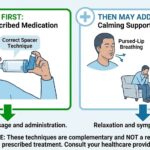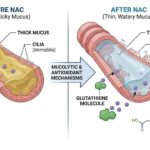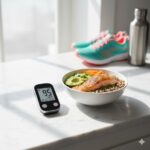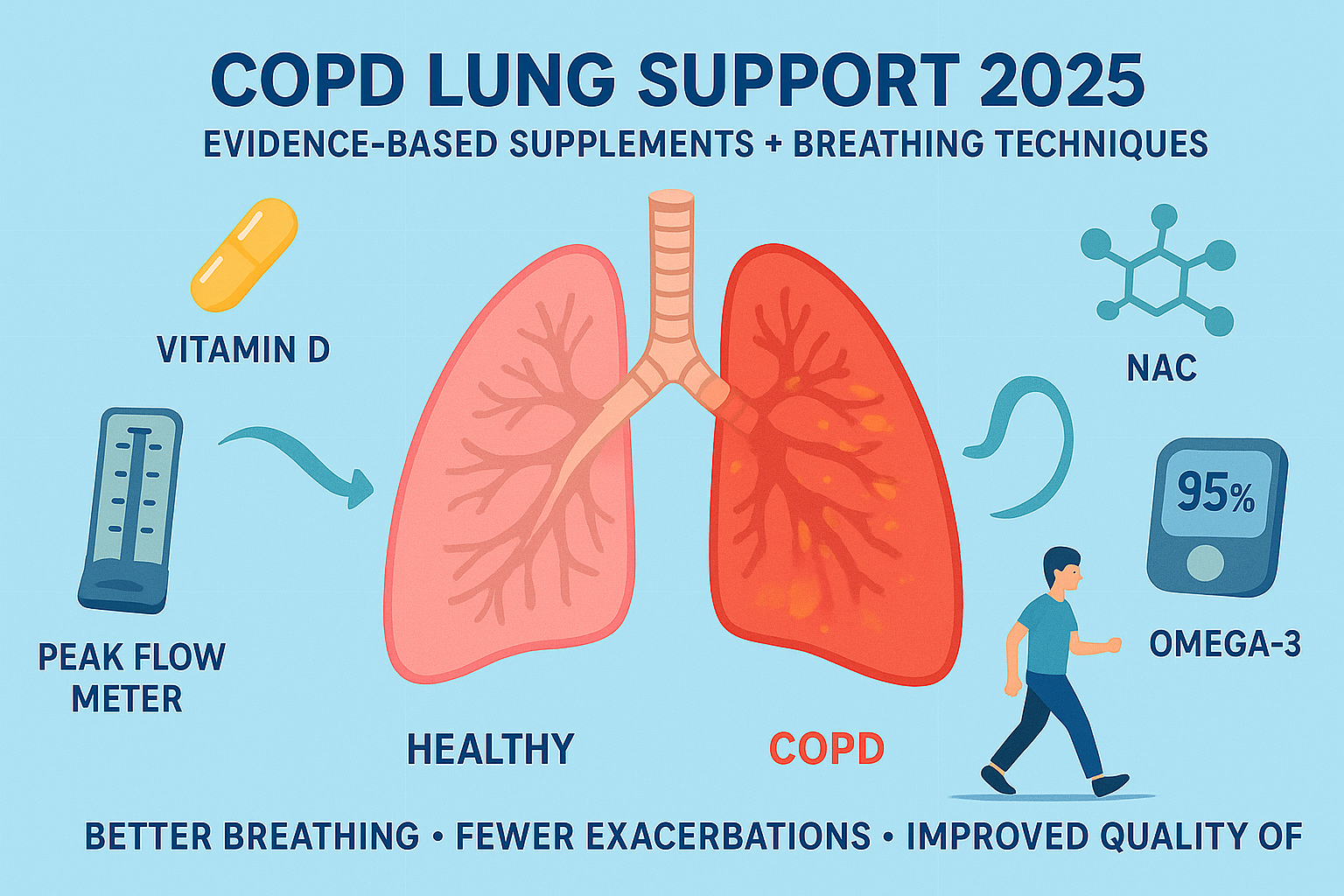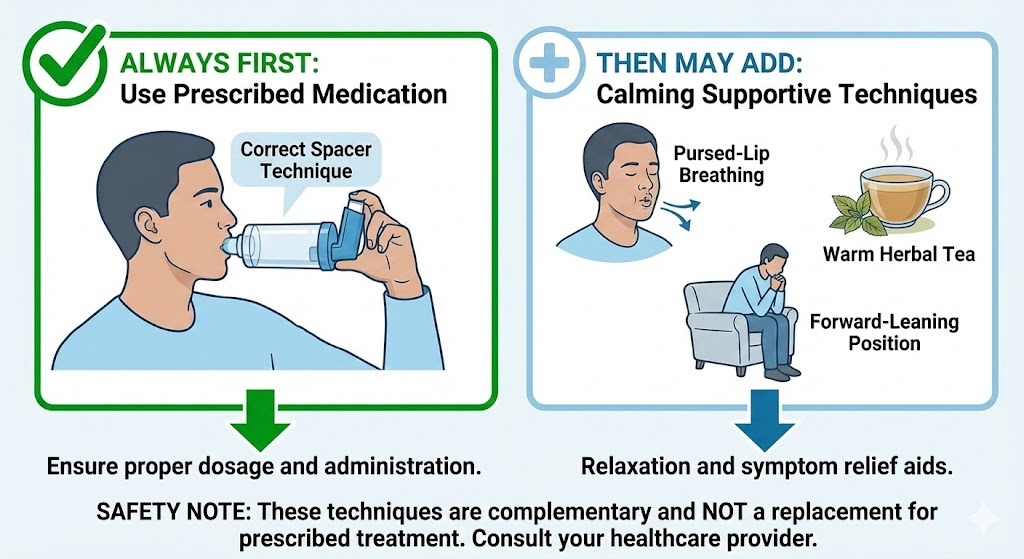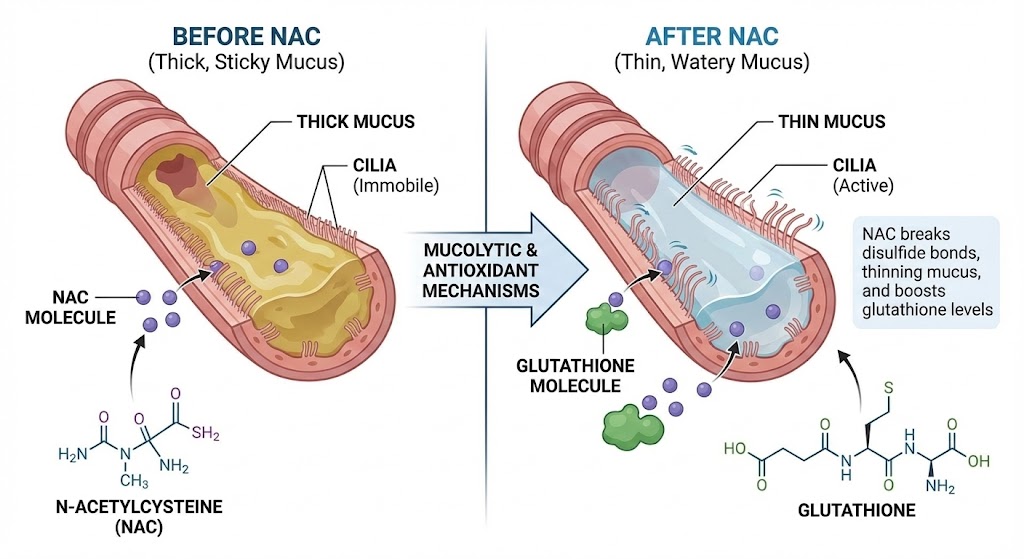Understanding COPD: More Than Just “Smoker’s Cough”
COPD (Chronic Obstructive Pulmonary Disease) involves progressive lung damage that makes breathing increasingly difficult. While there’s no cure, the right combination of supplements and breathing techniques can significantly improve quality of life and slow progression.
Key COPD Facts:
- 65 million people worldwide have moderate-severe COPD (WHO)
- Third leading cause of death globally
- Two main types: Emphysema (air sac damage) + Chronic Bronchitis (airway inflammation)
4 Evidence-Based Supplements for COPD Support
1. NAC (N-Acetylcysteine) – The Mucus Manager
How it helps: Breaks disulfide bonds in thick mucus, making it easier to cough up
Evidence: 600mg 2x/day reduced COPD exacerbations by 24% (European Respiratory Journal, 2023)
Best products: PureHealth Lung Support, quality NAC supplements
Important: Take with vitamin C for enhanced antioxidant effects
2. Vitamin D – The Exacerbation Reducer
How it helps: Modulates immune function, reduces inflammation
Evidence: COPD patients with adequate vitamin D had 45% fewer flare-ups
Dosage: 2,000-4,000 IU daily (test levels first)
Pro tip: Combine with calcium for bone health (common concern in COPD)
3. Omega-3 Fatty Acids – The Inflammation Fighter
How it helps: Reduces inflammatory markers in lung tissue
Evidence: Improved 6-minute walk distance by 18% in COPD patients
Best sources: High-EPA fish oil, algal oil (vegetarian)
Dosage: 2,000-3,000mg daily
4. Mullein-Based Formulas – The Bronchial Soother
How it helps: Reduces bronchial inflammation, acts as natural expectorant
Evidence: Traditional use + modern studies show improved mucus clearance
Best products: Breathe Drops (contains mullein, oregano, thyme)
User report: “I cough less and sleep better since adding Breathe Drops to my routine”
Specialized Formulas for Specific COPD Needs
For Energy & Oxygen Utilization:
Lung Expand Pro – Uses cordyceps and adaptogens to improve oxygen efficiency, particularly helpful for COPD-related fatigue
For Long-Term Lung Tissue Support:
Lignosus Tiger Milk Mushroom – Traditional mushroom blend studied for respiratory tissue repair
“After 6 months of NAC + Breathe Drops, my pulmonologist said my lung function decline has stabilized. I still have bad days, but they’re less frequent.”
— Robert T., Stage 2 COPD patient
🌿 Complementary Relief Methods for COPD
💨 Steam Therapy with Essential Oils
Many COPD patients find relief through steam therapy enhanced with respiratory-supportive essential oils. Peppermint oil in particular shows research benefits for:
- Opening congested airways through menthol’s cooling effect
- Reducing inflammation in irritated bronchial passages
- Providing immediate symptomatic relief during breathing difficulties
Safe usage for COPD: Always dilute properly and use in well-ventilated areas. Explore the scientific evidence for peppermint oil in respiratory health.
5 Breathing Techniques That Actually Help COPD
1. Pursed-Lip Breathing (Instant Relief)
How to do it:
- Inhale slowly through nose (2 seconds)
- Pucker lips like whistling
- Exhale slowly through mouth (4-6 seconds)
Benefit: Keeps airways open longer, reduces air trapping
2. Diaphragmatic Breathing (Strength Builder)
How to do it:
- Lie back, place hand on stomach
- Breathe in deeply through nose (stomach should rise)
- Exhale through pursed lips (stomach should fall)
Benefit: Strengthens diaphragm, more efficient breathing
3. Huff Coughing (Better Mucus Clearance)
How to do it:
- Take medium breath in
- Contract abdominal muscles to make “huff” sounds
- Repeat 2-3 times, then cough
Benefit: Clears mucus without exhausting yourself
4. Paced Breathing (For Activity)
How to do it:
- Inhale before starting activity (like standing up)
- Exhale during the strenuous part
Benefit: Prevents breathlessness during daily tasks
5. Coordinated Breathing (Exercise)
How to do it:
- Inhale through nose before the effort
- Exhale through pursed lips during the effort
Benefit: Makes physical activity more manageable
COPD Supplement Safety: Critical Guidelines
🚨 Never Stop Prescribed Medications
- Supplements are complementary, not replacements
- Bronchodilators and steroids are essential for COPD management
- Always discuss new supplements with your pulmonologist
🚨 Oxygen Therapy Comes First
- No supplement replaces needed oxygen
- Maintain oxygen saturation above 88-92% (as prescribed)
- Use supplements to support, not replace, medical treatment
🚨 Watch for Interactions
- NAC may enhance nitroglycerin effects
- Vitamin D can affect calcium metabolism
- Report all supplements to your healthcare team
Sample COPD Daily Routine
Morning:
- Pursed-lip breathing (5 minutes)
- NAC 600mg + Vitamin D 2,000 IU
- Light breakfast, avoid heavy meals that pressure diaphragm
Afternoon:
- Breathe Drops as needed for congestion
- Diaphragmatic breathing practice
- Short walk with paced breathing
Evening:
- Omega-3s with dinner
- Huff coughing if mucus is bothersome
- Relaxation breathing before sleep
FAQ: COPD Supplement Questions
1. Can supplements reverse COPD damage?
No, but they can slow progression and improve symptoms.
2. Best supplement combination for severe COPD?
NAC + Vitamin D + Protein supplements (malnutrition is common)
3. Are breathing techniques really that important?
Yes – they can be as impactful as medications for daily symptom management.
4. When should I avoid supplements?
During acute exacerbations – focus on emergency medical care first.
5. Can I use Breathe Drops with oxygen therapy?
Yes, but discuss with your doctor and use as complementary support.
6. What’s the difference between COPD supplements and general lung health supplements?
COPD-specific needs:
- Higher antioxidant doses (combat chronic inflammation)
- Mucus management focus (NAC, mullein)
- Muscle preservation (protein, creatine)
- Energy support (CoQ10, B vitamins)
General lung supplements may not address COPD’s unique challenges
7. Can breathing techniques really improve my oxygen levels?
Yes, specific methods help:
- Pursed-lip breathing improves oxygen exchange
- Diaphragmatic breathing increases efficiency
- Pacing techniques prevent oxygen desaturation during activity
Most patients see 2-4% O2 saturation improvement with proper technique
8. How long until I notice benefits from COPD supplements?
Timeline varies:
- Symptom relief (2-4 weeks): Reduced mucus, easier breathing
- Functional improvement (1-3 months): Better exercise tolerance
- Long-term benefits (3-6 months+): Fewer exacerbations, slower decline
Consistency is crucial with COPD management
9. Are there any supplements that can make COPD worse?
Use caution with:
- High-dose iron (may increase oxidative stress)
- Certain herbs (can interact with medications)
- Stimulants (increase breathing rate unnecessarily)
- Products with fillers (may irritate sensitive airways
10. What’s the most important breathing technique for COPD patients?
Pursed-lip breathing takes priority because it:
- Keeps airways open longer
- Reduces shortness of breath immediately
- Can be used during any activity
- Requires no special equipment
Master this before learning other techniques
11. Can supplements reduce my need for COPD medications?
Never reduce medications without medical supervision. Supplements should complement your treatment plan. Some patients may eventually need less rescue medication, but this should be guided by pulmonary function tests and doctor’s assessment.
12. What should I look for in a protein supplement for COPD?
Ideal characteristics:
- Whey or plant-based protein (easily digestible)
- No artificial sweeteners (can cause breathing issues)
- Low carbohydrate content (carbs produce more CO2)
- Added branched-chain amino acids (preserve muscle mass)
13. How do I know if my breathing techniques are working correctly?
Signs of proper technique:
- Reduced breathing rate at rest
- Less use of accessory neck/shoulder muscles
- Decreased shortness of breath during daily activities
- Improved ability to speak in full sentences
Consider working with a pulmonary rehab specialist initially
14. Are there supplements that help with COPD-related fatigue?
Energy-support options:
- CoQ10 (cellular energy production)
- B-complex vitamins (energy metabolism)
- Creatine (muscle strength and endurance)
- L-carnitine (fatigue reduction)
Address malnutrition first, as it’s a major fatigue cause
15. Can breathing exercises help during a COPD exacerbation?
During mild exacerbations:
- Pursed-lip breathing can help manage anxiety
- Positioning techniques ease breathing effort
- Pacing methods conserve energy
During severe exacerbations: Focus on medical care and use oxygen as prescribed
16. What’s the role of antioxidants specifically in COPD?
Critical functions:
- Neutralize free radicals from chronic inflammation
- Protect lung tissue from further damage
- Support immune function in damaged airways
- Reduce exacerbation frequency
COPD creates 10x more oxidative stress than healthy lungs
17. How often should I practice breathing techniques?
Daily practice schedule:
- Formal practice: 10-15 minutes, 2 times daily
- Informal application: Use techniques during all activities
- “Breathing breaks”: 1-minute sessions every 2-3 hours
Consistent practice builds muscle memory and effectiveness
18. Are liquid supplements better than pills for COPD patients?
Liquid advantages:
- Easier swallowing (common issue in advanced COPD)
- Faster absorption (important during exacerbations)
- Better hydration (often needed in COPD)
- Easier dosage adjustment
Pill advantages: Longer shelf life, more concentration options
19. Can supplements help with the anxiety that comes with COPD?
Some supportive options:
- Magnesium (natural calming effect)
- L-theanine (reduces anxiety without sedation)
- Omega-3s (support brain health and mood)
- Ashwagandha (adaptogen for stress response)
Always address breathing-related anxiety with techniques first
20. What’s the most overlooked supplement for COPD patients?
Vitamin D is critically important because:
- 80% of COPD patients are deficient
- Reduces exacerbation risk by 40-50%
- Supports immune function in damaged lungs
- Helps prevent osteoporosis (common COPD complication)
Get levels tested and supplement accordingly
21. Can steam therapy with peppermint oil help COPD symptoms?
Yes, when used safely as complementary relief. Peppermint oil in steam therapy can provide:
- Immediate congestion relief through menthol’s cooling sensation
- Reduced inflammation in irritated airways
- Improved mucus clearance when combined with proper techniques
Important safety notes for COPD: Never use during acute exacerbations. Always ensure proper ventilation. Read the complete scientific review of peppermint oil for respiratory health.
💡 Maximizing Your COPD Management
For comprehensive symptom relief, combine evidence-based supplements with complementary approaches:
- Internal support: Use proven supplements like NAC and vitamin D
- Breathing techniques: Practice pursed-lip and diaphragmatic breathing
- Symptomatic relief: Consider steam therapy with research-backed essential oils
Note on essential oils: While not substitutes for medical treatment, certain oils like peppermint can provide valuable symptomatic support. Learn about peppermint oil’s role in respiratory comfort.
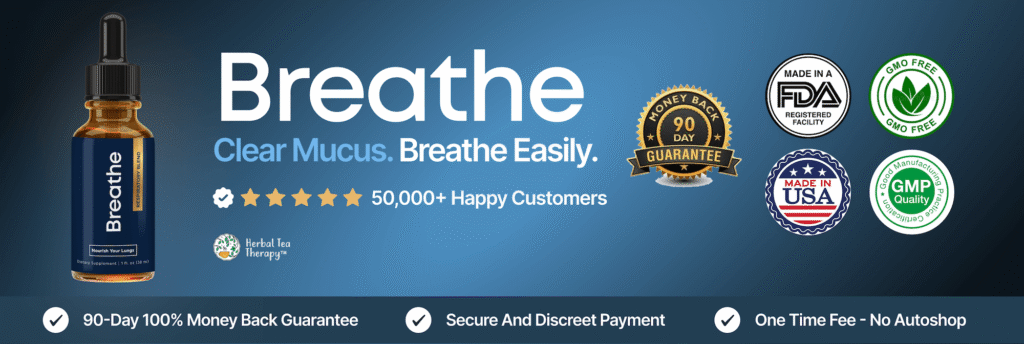
Click on Image above to See if Available Today.
🌿 Looking for Comprehensive Lung Support?
Compare top-rated supplements specifically formulated for respiratory health
🏆 View Our 2025 Lung Supplement ComparisonNeed personalized breathing guidance?
💨 Take Our Lung Health Assessment


